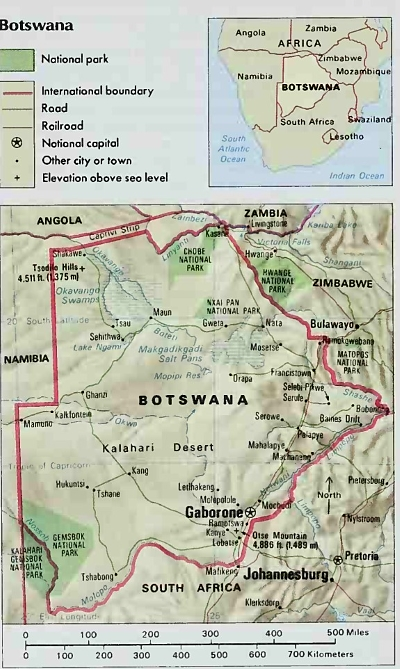Botswana. Economy. History
Land and climate. Botswana lies on a huge plateau and has an average altitude of about 3,300 feet (1,010 meters) above sea level. The land is hilly in the east and flat or gently rolling elsewhere. Eastern Botswana has the most fertile land, and about 80 percent of the people live there. Forests cover parts of the north. The Kalahari
Desert occupies almost all the central and southwest areas of the country. Bushes and grass grow in most of the Kalahari, but the southwest has sand dunes and little plant life.
The Okavango River rises in Angola and flows into northwestern Botswana. There, the river divides into streams and forms the Okavango Swamps.

Botswana has a dry, subtropical climate. In summer, which lasts from October to April, daytime temperatures often reach 100 °F (38 °C). Winter days are warm, but the temperature often falls below freezing at night. Average annual rainfall ranges from 22 inches (56 centimeters) in the east to 12 inches (30 centimeters) in the west. Droughts occur frequently.
Economy. Botswana is a poor country, but its economy is developing rapidly. The nation's two chief industries are mining and the raising of livestock, especially cattle. Copper, diamond, and nickel deposits were discovered in Botswana in the late 1960's and the 1970's and are being developed today. Botswana also has deposits of coal and cobalt. Farmers raise corn, millet, sorghum, and other crops. Botswana is developing its manufacturing through government encouragement of private enterprise and foreign investment.

Botswana's chief exports are beef, diamonds and other mineral products, hides and skins, and textiles. Leading imports include chemicals, food, fuel, machinery, and transportation equipment. Botswana's chief trading partners are South Africa, the United Kingdom, the United States, and Zimbabwe.
Botswana's economy depends heavily on South Africa for investments, markets, and technical skills. Most of Botswana's imports and exports travel on a railroad that runs through South Africa to the sea.
Botswana has about 9,300 miles (15,000 kilometers) of roads, most of which are unpaved. Airports serve Francistown, Gaborone, and other major urban areas.
History. In prehistoric times, the San lived in what became Botswana. Sometime between A.D. 1 and A.D. 1000, the Tswana came to the area from the north. They settled in the fertile eastern lands and pushed the San into the Kalahari region.
During the 1800's, the Tswana fought with rival black African groups and with white settlers from what is now South Africa. The Tswana sought European support against their enemies. In the late 1800's, Britain brought the area that is now Botswana under its protection.
In 1895, this area became known as the Bechuanaland Protectorate. Britain governed the area until the 1960's. The South African government asked Britain several times to transfer the protectorate to South Africa, but the British refused to do so.
The Bechuanaland Protectorate gained independence as the Republic of Botswana on Sept. 30, 1966. Seretse Khama became the nation's first president.
Botswana's economy has grown rapidly since independence. South Africa has provided the country with technology and other assistance. In addition, Botswana has sought closer ties with Angola, Mozambique, Tanzania, and Zambia. An all-weather road from southern Botswana to Zambia was completed in 1977.
The National Assembly reelected President Khama in 1969, 1974, and 1979. Khama died in 1980. The National Assembly elected Quett Ketumile Joni Masire to succeed Khama as president. It reelected Masire, now known as Sir Ketumile Masire, in 1984, 1989, and 1994. Masire resigned as president in 1998. Vice President Festus Mogae succeeded him. Mogae remained president following elections held in 1999.
Date added: 2023-02-04; views: 859;
